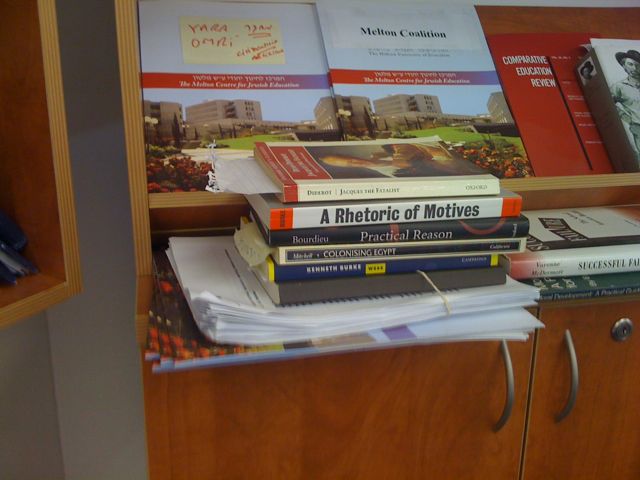A week ago I spent the morning meeting with an Israeli cultural anthropologist and education scholar well-known for his work on Peace education, Prof. Zvi Beckerman. As soon as I entered his office, I immediately felt at home, as the books from some of my favorite rhetoricians-- Kenneth Burke, Chaim Perelman, and others-- were sitting right there on his shelf, piled up and in plain view.

I first met Zvi more than 12 years ago, when I was volunteering for the Center for Bi-Lingual Education (Merkaz La’Hinuch Du Lashoni). Founded in 1997 by American Lee Gordon, the non-profit, also known by the moniker Hand-in-Hand (or the Hebrew Yad B’Yad), aims to build bilingual schools to provide a rare opportunity for Jewish Israelis and Palestinian Israelis to come together around the shared cause of education. The idea, at least in its inception, was that the classes would be conducted 50% in Hebrew and 50% in Arabic. When I was volunteering in 2000-2001, there were only three schools—one in Jerusalem, one in the North, and the beginning of a Gan (kindergarten) in Tel Aviv. When I met with Prof. Beckerman last week, I learned that there are now 5 schools and more poignantly, for me at least, that the students I met in their first year in 2000 had become the first graduating class in 2011.
Of course, as a non-paid volunteer, I spent most of my time in 2000-2001 trying to do much-needed grant research and less time interacting with the young pupils. When I did visit the Jerusalem and Northern classrooms, I was awed and amazed by the instructors’ patience and even more convinced that I was best equipped to teach at the college and not the elementary level. As a young graduate student with little experience in grant-writing, I’m not sure how much my efforts benefitted them, if at all. But volunteering for them certainly had a significant impact on me, and helped me to better understand how rare the opportunities for significant interaction between Jewish and Arab (Palestinian) Israelis are, and just how difficult the idea of integrated schools is to pull off in a country whose education system is divided up along so many different lines. Secular Jewish Israelis go to one set of schools, ultra-Orthodox Jewish Israelis have their own schools, and Arab (Palestinian)-Israelis have their own schools as well. Given how segregated the education system is, the idea of a bilingual school is quite remarkable and unusual.
Sadly, just a few days after I met with Zvi, the following headline was on the second page of Haaretz: “Racist graffiti scrawled on Jerusalem monastery, Jewish-Arab school.”
As part of the price-tag campaign, the Bilingual school in Jerusalem and a Greek monastery not too far from our apartment had been targeted. “Death to the Arabs” and “Kahane Was Right” were spray-painted on the school's playground. Thankfully, classes had been cancelled so the young students didn't have to see it on their way to school. I teared up when I read it, and I tear up as I write about it.


